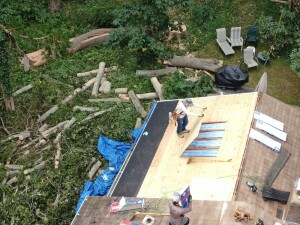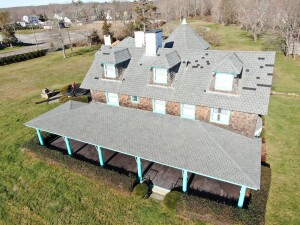In most cases, modern roofing materials and installation techniques allow roof installers to protect their client’s homes from
the elements. That said, nor’easters, tropical storms, or hurricanes such as Hurricane Henri can present roof integrity challenges for homeowners. The threats these storms represent go beyond the obvious damage of fallen trees or fallen limb damage. This is because many severe weather elements can occur during these storms, especially a hurricane. For this type of damage, an emergency hurricane damage inspection may be in order.
Depending on the storm, you can count on high winds, heavy, wind-driven rain, lightning strikes, and hail to occur. Any of these elements on their own can damage your roof but when these harsh weather elements occur in unison, like in a hurricane, the damage tends to be worse. Damage inflicted by high winds, for example, can worsen significantly when accompanied by heavy rains.
Given this, we wanted to spend a little time detailing how your roof might be damaged during a hurricane aside from the readily observable impact of a fallen tree or crashing limb.
How High Winds Affect Your Roof
Hurricanes are classified as having sustained winds of at least 74 miles per hour. Anything weaker is classified as a tropical storm. Wind gusts during even a category one hurricane could, at times, reach 150 miles per hour or more. Winds this strong have the potential to directly impact your roof by ripping off shingles, roof tiles, and even the roof deck. However, even if these winds don’t remove roofing materials entirely, they can compromise their integrity by raising them, twisting them or bending them – allowing water incursion (see below).
What’s more, high winds can also indirectly affect roof integrity by causing tree limbs, flying objects, and smaller debris to crash onto your home. The impact from these flying objects can cause shingles and tiles to fall away, or even create holes through your roof.
How Heavy Rains Affect Your Roof
Heavy and sustained rain, typical in hurricanes, can cause excessive wear and tear, loosen shingles, and prematurely “age” a roof – potentially needing replacement sooner than would otherwise be necessary. But the real problem, as referenced above, with heavy rain during hurricanes is when a roof has already sustained damage and compromised integrity. When heavy and prolonged rains accompany this damage, the roofing structure can suffer severe water damage.
How Hail Affects Your Roof
While hail doesn’t occur with all hurricanes, the risk of it does exist and there isn’t much you can do to prevent it from damaging your roof. Once hail has created holes in your roof, the only thing you can do is repair or replace it. If hail is small and infrequent, it may only loosen shingles or chip away at the outer layers of your roofing structure. But larger hailstones can cause dramatic damage by displacing shingles, denting or cracking shingles, or breaking the seal beneath the shingles to allow wind and water damage. Each of these situations may necessitate the replacement of portions of your roof.
How Lightning Strikes Affect Your Roof
Although the risk of a direct strike on your roof is minimal, the possibility that it will happen is increased during hurricanes. The most likely outcome when lightning strikes your roof is that it might punch a hole through it, leaving your home open to water damage. Lightning can also cause the burning or searing of roofing elements. In the worst – and least likely case – lightning can cause a fire to erupt. Of all the scenarios of storm damage to your roof, a lightning strike is the least likely to occur.
Minimizing Storm Damage Due to Hurricanes
No matter what precautions you take, there always exists the possibility your roof will become damaged during a strong storm like a hurricane. A roof in good condition is generally less likely to take severe damage. In the pound of prevention is worth a penny of cure department, if you live in an area prone to hurricanes, you should have an annual roof inspection done before storm season. These inspections should be done by a professional, who will look at your shingles and use specialized equipment to check for weak spots in your roof’s foundation. If anything is found to be wrong, you can use the same contractor to fix your roof.
Obviously, major and catastrophic damage should be dealt with immediately as it threatens your home and its contents (including you and your family!). When it comes to some of the minor damage detailed above (missing or bent shingles, sections of roof impacted by objects, etc.), it should be taken care of as soon as possible. This is because when left unchecked, even minor damage can turn into a severe problem. A professional roofing expert can help you determine whether your damage can be repaired or whether the roof will need replacement.
More Questions About How Hurricane Damage Impacts Your Roof? Or Has Your Roof Been Damaged By A Recent Storm?
Do you have more questions about how hurricane storm damage affects your roof? Would you like to schedule a roofing inspection before the hurricane season becomes active? Or do you suspect your roof has sustained damage from a recent storm? Contact us today to schedule an in-person evaluation of your roof. If it’s an emergency, call us on 1 (203) 745-5028.


